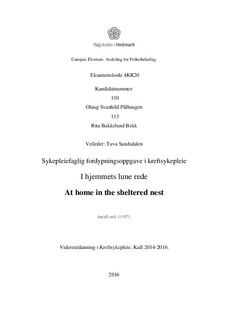| dc.contributor.author | Pålhaugen, Olaug Svanhild | |
| dc.contributor.author | Bekk, Rita Bakkelund | |
| dc.date.accessioned | 2016-09-16T07:19:58Z | |
| dc.date.available | 2016-09-16T07:19:58Z | |
| dc.date.issued | 2016 | |
| dc.identifier.uri | http://hdl.handle.net/11250/2407686 | |
| dc.description | Fordypningsoppgave i kreftsykepleie, 2016 | nb_NO |
| dc.description.abstract | I Norge vil omkring 700 barn og unge miste en av foreldrene i kreft i løpet av et år. Kreftsykepleiere møter oftere barn som pårørende, da dette er en pårørendegruppe som har økende fokus og at det legges til rette for at flere får dø hjemme.
I denne oppgaven har vi valgt å fokusere på hvordan kreftsykepleier gjennom kommunikasjon, kan skape trygghet for barnet når mor eller far ønsker å dø hjemme. Å forholde seg til døden er ofte veldig fremmed for barn. Maslow beskriver trygghet som behovet for blant annet struktur og sikkerhet, frihet fra frykt, kaos og engstelse. Evnen til å forutsi eller forberede seg på et hendelsesforløp er knyttet til det å være trygg. Hvis man er trygg vil man være i stand til å forholde seg til noe som kan skje, eller man vet skal skje.
Sorg hos barn kan gi utslag som blant annet; angst, redsel og utrygghet. Det er viktig at kreftsykepleier er åpen for de følelser og reaksjoner som oppstår hos pårørende, og aksepterer at alle former for reaksjoner er normalt. Videre skal kreftsykepleier bistå med korrekt og tilpasset informasjon for å kunne bidra til en åpenhet mellom pårørende og den døende. Å snakke med barn om døden på en naturlig måte er vanskelig for mange, dette til tross for at barn alltid stiller spørsmål ut ifra egen evne til å forstå. Barn blir lett misforstått, og man tillegger de ikke reelle opplevelser for sorg. Barn går inn og ut av sorgen, dette betyr ikke at barnet ikke sørger, men at sorgen får utløp på barns vis.
For oss er det naturlig å tenke at det er lettere for en voksen å hjelpe og trygge et barn, svare på eventuelle spørsmål som oppstår, hvis voksenpersonen har god informasjon om hvilken situasjon barnet og dens familie er i. | nb_NO |
| dc.description.abstract | Engelsk sammendrag (abstract): In Norway, about 700 children and young people lose one of their parent to cancer within a year. Oncology nurses meet more often children as relatives, because this is a group that gets more attention now a days and taken to ensure that more people die at home. We have chosen to focus on how oncology nurse, through communication, can create the sense of security for children, when their mother or father wishes to die at home. Dealing with death is often foreign to children. Children in grief can among another things, feel anxiety, fear and insecurity. It is important that we are open for those feelings and reactions that occur in children, and accepts that all the reactions are normal. We will also assist with accurate and personalized information to help increase an open relationship between the relatives and the dying. Talking to children about death in an natural way is difficult for many people, this despite the fact that children are always asking questions based on their ability to understand. Children are easily misunderstood, and they attach to the non-real experiences of grief. Children move in and out of grieving, this does not mean that the child does not grief, however, that grief is unleashing on children's terms. Maslow describes security as one of the basic needs for among other things, structure and security, freedom from fear, chaos and anxiety. The ability to predict or prepare for the chain of events linked to it, helps the child to feel safe. For us it`s natural to think that it is easier for an adult to help and secure a child, answer any questions that arise, if the adult person has good qualifications in communication, on what situation the child and its family are experiencing. | eng |
| dc.language.iso | nob | nb_NO |
| dc.subject | informasjon | |
| dc.subject | hjemmedød | |
| dc.subject | trygghet | |
| dc.subject | communication | eng |
| dc.subject | parents with cancer | eng |
| dc.subject | home death | eng |
| dc.subject.mesh | kreftsykepleie | |
| dc.subject.mesh | kreftsykepleier | |
| dc.subject.mesh | kommunikasjon | |
| dc.subject.mesh | foreldre | |
| dc.subject.mesh | kreft | |
| dc.subject.mesh | cancer | eng |
| dc.subject.mesh | parental død | |
| dc.subject.mesh | parental death | eng |
| dc.subject.mesh | children | eng |
| dc.subject.mesh | next of kin | eng |
| dc.subject.mesh | oncology nursing | eng |
| dc.title | I hjemmets lune rede | nb_NO |
| dc.title.alternative | At home in the sheltered nest | nb_NO |
| dc.type | Student paper, others | nb_NO |
| dc.subject.nsi | VDP::Medical disciplines: 700::Health sciences: 800::Nursing science: 808 | nb_NO |
| dc.source.pagenumber | 51 s. | nb_NO |
